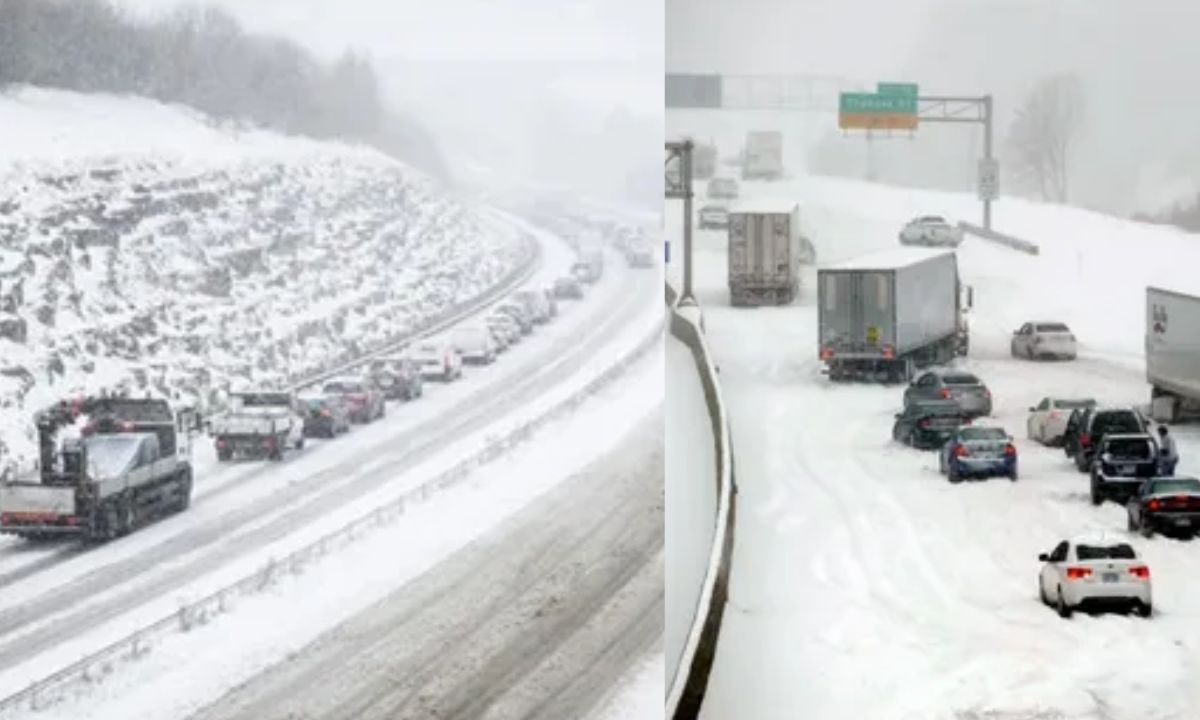As December progresses, the UK is gearing up for a potentially dramatic shift in weather. Meteorologists are cautioning about a major snowstorm that could cover much of the country in deep snow. This weather pattern might bring the first truly widespread White Christmas in several years.
Intense snowfall, slippery surfaces, and freezing winds are expected.The country is getting ready for both possible disruptions and a touch of holiday charm. Weather specialists anticipate travel delays as well as picturesque winter scenes. Emergency teams have already initiated their preparations.
The Snowstorm Approaching the UK: Anticipated Developments
Meteorologists are tracking a substantial Arctic air mass moving southward toward the British Isles. As it merges with moist Atlantic air, this system is forecasted to produce widespread and heavy snowfall across much of the UK.
According to weather models, the snow is expected to begin in Scotland and Northern Ireland before progressing into England and Wales just ahead of Christmas Eve and Christmas Day. The Met Office has already issued preliminary alerts to help the public prepare in advance.
A Variety of Winter Conditions
In addition to snow, a range of wintry conditions is predicted to arrive with the approaching weather system. Areas, particularly in central and southern England, may experience sleet, freezing rain, and frost.
Sharp drops in temperature could cause rainfall to instantly freeze on contact, leading to hazardous icy patches on roads and pavements. Local councils are stocking up on salt and grit to treat affected surfaces.
Wind and Cold: Additional Difficulties
Powerful winds are also expected to intensify the storm’s impact. Gusts reaching up to 60 mph are likely along exposed coastal and high-altitude regions, creating whiteout or blizzard-like conditions in certain spots. The combination of drifting snow and reduced visibility will pose serious travel risks.
Temperatures are forecasted to plunge significantly, marking the coldest stretch in several years, with sub-zero conditions widespread across the UK. Citizens are being urged to avoid unnecessary travel and limit outdoor activity during the most severe phases of the storm.
The Effects of the Snowstorm Throughout the UK
The snowstorm’s effects will vary significantly across regions:
- Scotland and Northern Ireland will face 15-30 cm of snow starting December 22-23
- Northern England expects 15-25 cm of snow during December 23-24
- Midlands and Wales will see 10-20 cm with mixed precipitation on December 23-24
- Southern England anticipates 5-15 cm of rare snowfall by December 24-25
Key concerns include road closures, power outages, rural isolation, and significant transport disruption. Local emergency services are preparing for region-specific challenges based on these anticipated conditions.
Northern and Highland Regions: The Areas Most Affected by Snow
The Scottish Highlands, Northumberland, Cumbria, and parts of Yorkshire are expected to face the most severe impact of the approaching snowstorm. Forecasts indicate snowfall accumulations ranging from 20 to 30 cm (8 to 12 inches), with even higher drifts anticipated over elevated terrain.
These conditions could lead to localized road closures, school cancellations, and potential power disruptions. Emergency services are bracing for a spike in incidents and have begun early preparations. Residents in the affected areas are being urged to complete critical shopping and make necessary arrangements ahead of the storm’s arrival.
Southern England: Bracing for an Unusual White Christmas Amid Major Snow Threat
Usually spared from extreme winter weather, southern England is now under heightened alert. If the forecast holds, London and nearby counties may witness the rare occurrence of a White Christmas.
Despite the visual charm such weather brings, authorities are warning of serious disruptions. Transport networks—including rail services, airports, and motorways—are expected to face significant strain during one of the year’s busiest holiday travel windows.
The Dangers of Ice and Travel Interruptions
One of the most serious threats posed by the storm is the formation of black ice. As slushy snow refreezes overnight, slick and dangerous surfaces will heighten risks for both drivers and pedestrians.
Train operations could suffer delays from frozen tracks, while airports may encounter hold-ups from aircraft de-icing and potential flight cancellations. With the holiday season in full swing, these issues are expected to impact a large number of travelers. Emergency services are anticipating a rise in weather-related incidents and are already mobilizing in preparation.
Strategies for Snowstorm Preparation and Personal Safety
Winterize Your Vehicle to Enhance Safety
Before setting out, inspect your tire treads and confirm they have adequate pressure. Top up your vehicle’s antifreeze levels and ensure your battery is functioning properly. Keep a winter emergency kit in your car that includes essentials such as warm blankets,
bottled water, non-perishable snacks, a flashlight, and a small shovel. If travel during the storm is unavoidable, consider installing winter tires for added grip and safety.
Dress in Layers to Protect Against Severe Cold
Use multiple layers of clothing when venturing outside. Start with thermal undergarments and add insulating middle layers. Top with waterproof outerwear to stay dry in mixed precipitation. Don’t forget extremities – wear waterproof gloves, thick socks, and insulated boots.
Monitor Weather Alerts Closely
Stay updated with the latest Met Office warnings. Utilize weather apps, local news, and official websites for real-time updates. Enable emergency notifications on your mobile devices. Follow transportation updates if travel is unavoidable during the storm period.
Frequently Asked Questions
When will the snowstorm reach the UK?
Northern areas will see snow beginning December 22, with southern regions affected by Christmas Eve.
How long will the snow last on the ground?
Below-freezing temperatures suggest snow could remain for 3-5 days in most regions.
Will public transportation continue running?
Reduced services are expected, with some route cancellations likely in heavily affected areas.
Should I cancel my Christmas travel plans?
Consider flexible arrangements and prepare for significant delays if travel is necessary.
What should I do if I lose power during the storm?
Keep warm clothing, alternative light sources, and non-perishable food supplies readily available.
Summary
The UK is standing on the threshold of a historic winter event. A significant snowstorm promises not only disruptions but also the nostalgic allure of a White Christmas. While the picturesque landscapes are highly anticipated, the public must prioritize safety.
Weather patterns can change quickly, and conditions could escalate from manageable to hazardous with little warning. Citizens should remain vigilant and follow official guidance as the situation develops.
Final Thoughts on the Upcoming Snowstorm
As excitement builds for a rare snowy Christmas, preparation becomes increasingly important. The combination of holiday travel volume and severe weather creates a particularly challenging situation for both individuals and emergency services. Community cooperation will be essential during this weather event, helping the nation weather this storm safely while still enjoying the seasonal beauty it brings.
Safety Recommendations for Severe Winter Weather
To stay safe during intense winter storms, consider the following key precautions:
- Avoid Travel Unless Absolutely Necessary: Stay indoors during the height of the storm and only travel if it’s essential.
- Stock Up on Essentials: Ensure you have a supply of food, drinking water, medications, and heating fuel or alternatives in case of prolonged outages.
- Look After Vulnerable Individuals: Check in on elderly neighbors, relatives, or others who may need assistance during extreme weather.
- Watch for Ice: Be alert to the danger of black ice on sidewalks, driveways, and roads—it can be nearly invisible and extremely slippery.
- Stay Informed: Follow guidance and updates from local emergency services and official weather agencies.
Keep in mind: No errand or trip is worth putting yourself at risk. If possible, delay non-essential activities until conditions are safer.
For more updates and articles, visit the website:marrygeneral.com












